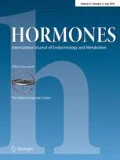Abstract
“Lady with an Ermine” (1489–1490) is an oil on walnut portrait by the Italian artist Leonardo da Vinci. The portrait’s subject is Cecilia Gallerani, the favorite mistress of Ludovico Sforza, known as “il Moro”, Duke of Milan. It was painted around the time of Cecilia’s pregnancy with Ludovico’s illegitimate son. Leonardo’s paintings are famous for hiding mysteries; thus, the truth about the “Lady with an Ermine” is still unclear. However, the solution to this enigma could be more evident than expected. Our hypothesis is that Cecilia might have suffered from pregnancy-induced Cushing syndrome.

Similar content being viewed by others
References
Shell J (1992) Sironi G Cecilia Gallerani: Leonardo’s Lady with an Ermine. Artibus Et Historiae 13(25):47–66
Kemp M (2019) Leonardo da Vinci: The 100 Milestones. Sterling, New York City, New York. isbn:978-1454930426
Soranzo A, Newberry M (2015) The uncatchable smile in Leonardo da Vinci’s La Bella Principessa portrait. Vis Res 113:78–86. https://doi.org/10.1016/j.visres.2015.05.014
Lazzeri D, Pozzilli P (2018) “Madonna of the carnation”: Leonardo da Vinci (1452-1519). J Endocrinol Investig 41(7):879–880. https://doi.org/10.1007/s40618-018-0842-z
Martino E, Vitti P (2014) Endocrinology and art. Leonardo da Vinci “design of lady with Graves' disease” (1452-1519). J Endocrinol Investig 37(8):781. https://doi.org/10.1007/s40618-014-0099-0
Chaudhry HS, Singh G (2020) Cushing syndrome. In: StatPearls. StatPearls Publishing Copyright © 2020, StatPearls Publishing LLC., Treasure Island (FL)
Ildefonso-Najarro SP, Plasencia-Dueñas EA, Benites-Moya CJ, Carrion-Rojas J, Concepción-Zavaleta MJ (2020) Pregnancy during the course of Cushing’s syndrome: a case report and literature review. Endocrinol Diabetes Metab Case Rep 2020:20–0022. Online ahead of print. https://doi.org/10.1530/edm-20-0022
Rask E, Schvarcz E, Hellman P, Hennings J, Karlsson F, Rao C (2009) Adrenocorticotropin-independent Cushing’s syndrome in pregnancy related to overexpression of adrenal luteinizing hormone/human chorionic gonadotropin receptors. J Endocrinol Investig 32(4):313–316
Wy LA, Carlson HE, Kane P, Li X, Lei ZM, Rao CV (2002) Pregnancy-associated Cushing’s syndrome secondary to a luteinizing hormone/human chorionic gonadotropin receptor-positive adrenal carcinoma. Gynecol Endocrinol 16(5):413–417. https://doi.org/10.1080/gye.16.5.413.417
Yin X, Liu J (2020) Estrogen receptor α plays an important role in Cushing’s syndrome during pregnancy. Med Hypotheses 143:109817. https://doi.org/10.1016/j.mehy.2020.109817
Author information
Authors and Affiliations
Corresponding author
Additional information
Publisher’s note
Springer Nature remains neutral with regard to jurisdictional claims in published maps and institutional affiliations.
Rights and permissions
About this article
Cite this article
Sisti, A., Sadeghi, P. Leonardo da Vinci: the Lady with an Ermine enigma. Hormones 20, 591–592 (2021). https://doi.org/10.1007/s42000-020-00264-0
Received:
Accepted:
Published:
Issue Date:
DOI: https://doi.org/10.1007/s42000-020-00264-0




